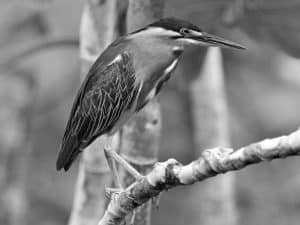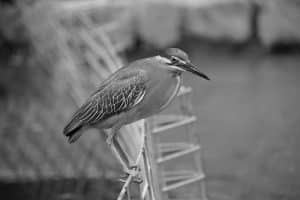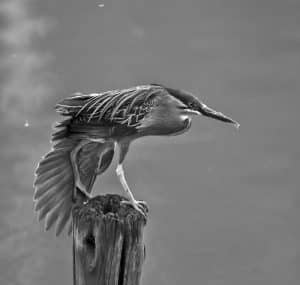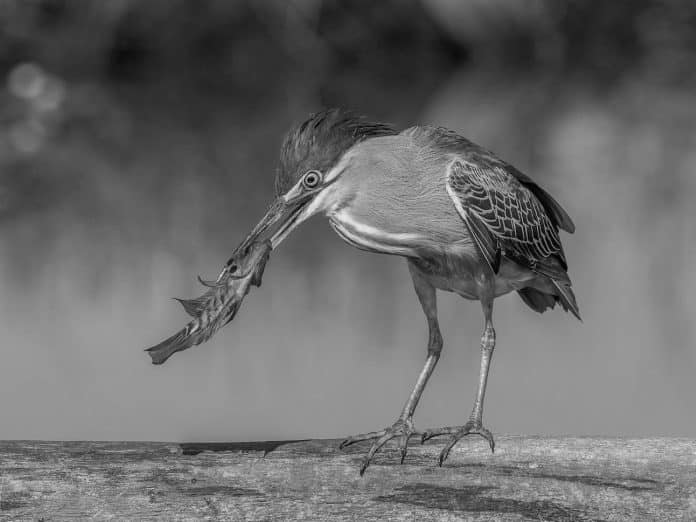Introduction to the Striated Heron
Welcome to the world of the striated heron in Tanzania, a captivating avian species that graces the waterways and wetlands of Tanzania with its elegant presence. Also known as the little heron, this bird belongs to the family Ardeidae and is scientifically classified as Butorides striata. With its distinctive plumage and graceful movements, the striated heron is a popular subject for birdwatchers and nature enthusiasts. Its slender form, long legs, and sharp beak make it an adept hunter, particularly in aquatic environments, where it effortlessly captures its prey. The striated heron is a master of stealth and patience, displaying remarkable agility and precision as it stalks its aquatic prey.

The striated heron is a small and stocky bird, measuring around 44-49 centimeters in length with a wingspan of approximately 70-83 centimeters. Its striking appearance is characterized by a combination of blue-grey upperparts, a white throat, and a distinctive streaked pattern on its neck and breast, which gives it the name “striated.” Its eyes are keen and piercing, allowing it to spot potential prey from a considerable distance. This remarkable bird exhibits a calm and composed demeanor, often seen perched near the water’s edge or wading stealthily through shallow waters in search of fish, amphibians, and other aquatic creatures.
The striated heron’s behavior is a testament to its adaptability and resourcefulness. It is primarily a solitary hunter, patiently waiting for the opportune moment to strike at its unsuspecting prey. Its ability to stand motionless for extended periods, coupled with its swift and precise movements when attacking, showcases the remarkable agility and predatory prowess of this avian marvel. Whether it’s standing stock-still on a submerged branch or delicately moving through the reeds, the striated heron is a testament to the beauty of nature’s design and the marvels of avian adaptation.
Habitat and Behavior of the Striated Heron in Tanzania
In Tanzania, the striated heron finds its ideal habitat in a diverse range of wetland environments, including coastal lagoons, mangroves, riverbanks, and freshwater marshes. The country’s rich array of ecosystems provides an abundance of foraging opportunities for these avian hunters. The striated heron’s preference for shallow, freshwater habitats, combined with its adeptness at navigating dense vegetation, makes it well-suited to the varied landscapes of Tanzania. Its ability to thrive in both coastal and inland wetlands underscores its adaptability and resilience as a species.
The behavior of the striated heron in Tanzania reflects its close association with water and its adeptness at hunting in aquatic environments. With its keen eyesight and lightning-quick reflexes, the heron is a formidable predator, capable of capturing a diverse range of aquatic prey. Whether it’s patiently waiting on the edge of a riverbank or stealthily navigating through the dense foliage of a mangrove swamp, the striated heron’s behavior is a testament to its mastery of aquatic hunting techniques. Its ability to coexist with other bird species in shared habitats further highlights its adaptability and ecological flexibility.
One of the most captivating behaviors of the striated heron is its distinctive hunting strategy. When stalking its prey, the heron adopts a characteristic hunched posture, with its neck retracted and its eyes fixed on the water below. This stealthy approach, combined with sudden lunges and precise strikes, allows the heron to secure its next meal with remarkable efficiency. Observing this behavior in the wild is a testament to the heron’s adaptability and its finely honed predatory instincts, making it a fascinating subject for birdwatchers and wildlife enthusiasts.
Conservation Status of the Striated Heron
The conservation status of the striated heron in Tanzania is of paramount importance, given the ecological significance of this species and its role in maintaining the balance of aquatic ecosystems. Classified as a species of least concern by the International Union for Conservation of Nature (IUCN), the striated heron benefits from its widespread distribution and relatively stable population. However, ongoing threats to wetland habitats, pollution, and human encroachment pose significant challenges to the long-term conservation of this remarkable bird.
The degradation of wetland ecosystems, driven by factors such as urbanization, agricultural expansion, and industrial development, directly impacts the natural habitats of the striated heron. Loss of nesting sites, disruption of foraging grounds, and decreased water quality all contribute to the vulnerability of this species. Furthermore, the indiscriminate use of pesticides and pollutants in aquatic environments poses a direct threat to the health and well-being of the heron and its prey species, leading to potential bioaccumulation of toxins within the food chain.
Conservation efforts aimed at protecting the striated heron and its habitat are crucial for ensuring the long-term survival of this species in Tanzania. Initiatives focused on wetland conservation, sustainable land use practices, and community engagement play a vital role in safeguarding the diverse ecosystems that support the heron’s existence. By raising awareness about the importance of wetlands and promoting responsible environmental stewardship, conservation organizations and local communities can work together to preserve the natural heritage of the striated heron and protect the fragile ecosystems on which it depends.
Where to Spot the Striated Heron in Tanzania

Tanzania offers a wealth of opportunities for birdwatchers and nature enthusiasts to observe the striated heron in its natural habitat. The country’s diverse array of wetland ecosystems provides ideal settings for encountering this captivating avian species. Coastal lagoons, estuaries, and mangrove swamps along the Tanzanian coast offer prime locations for spotting the heron as it navigates the intricate network of waterways and forages for its prey. Inland freshwater marshes, riverbanks, and wetland reserves also provide excellent opportunities for observing the heron’s graceful movements and distinctive hunting behavior.
The Rufiji River Delta, located in the Selous Game Reserve, stands out as one of the premier locations for encountering the striated heron in Tanzania. This expansive wetland complex, with its intricate network of channels and lagoons, provides an ideal habitat for the heron and a diverse array of other bird species. The tranquil waterways of the Rufiji River Delta offer a captivating setting for observing the heron’s hunting prowess and elegant presence amidst the rich tapestry of wetland flora and fauna.
The mangrove swamps of the Saadani National Park, situated along the Indian Ocean coast, also offer unique opportunities for observing the striated heron in its coastal habitat. These pristine mangrove ecosystems provide a vital breeding ground and foraging area for the heron, allowing visitors to witness its graceful movements and distinctive foraging behavior in a stunning coastal setting. Additionally, the freshwater marshes and riverine habitats of the Serengeti National Park and the Manyara region present further possibilities for observing the heron’s captivating presence in diverse inland wetland environments.
Best Time of Year for Birdwatching in Tanzania
For birdwatching enthusiasts seeking to encounter the striated heron and a wealth of other avian species, the timing of their visit to Tanzania plays a crucial role in maximizing their wildlife viewing opportunities. The country’s diverse ecosystems and seasonal variations offer distinct advantages for observing birds in their natural habitats, including the striking presence of the striated heron in wetland environments. Understanding the best time of year for birdwatching in Tanzania can enhance the experience of encountering this feathered marvel and appreciating the rich biodiversity of the region.
The dry season, spanning from June to October, stands out as an ideal period for birdwatching in Tanzania. During this time, the reduced vegetation and concentrated water sources draw a diverse array of bird species to key habitats, including wetlands, rivers, and lakes. The striated heron, with its affinity for aquatic environments, becomes more conspicuous during the dry season, making it an opportune time for observing its hunting behavior and elegant movements along the water’s edge. The abundance of migratory bird species, coupled with the favorable weather conditions, creates an optimal setting for birdwatching enthusiasts to explore Tanzania’s avian diversity.
Conversely, the wet season, which occurs from November to May, presents its own unique opportunities for birdwatching in Tanzania. The rejuvenation of wetland habitats, the proliferation of insect life, and the breeding activities of resident bird species all contribute to the dynamic nature of birdwatching during this period. The striated heron, amidst the seasonal fluctuations of water levels and the renewal of wetland ecosystems, demonstrates its adaptability and resilience as it continues to navigate its diverse habitats in search of sustenance and nesting opportunities. Birdwatchers visiting Tanzania during the wet season can witness the heron’s interactions with its environment and gain insights into its behavior across varying ecological conditions.
Tips for Observing the Striated Heron in the Wild
Observing the striated heron in the wild requires a combination of patience, strategic planning, and a respectful approach to wildlife viewing. Whether venturing into coastal lagoons, riverine habitats, or freshwater marshes, birdwatchers can enhance their chances of encountering this elegant avian species by following a few essential tips for observing the striated heron in its natural environment. These practical guidelines not only contribute to a rewarding wildlife experience but also promote responsible and ethical engagement with the natural world.
First and foremost, selecting the right time of day for birdwatching can significantly impact the success of observing the striated heron. Early morning and late afternoon are prime periods for encountering the heron as it engages in its hunting activities and displays its characteristic behaviors along the water’s edge. The soft, golden light of sunrise and sunset adds a captivating ambiance to the heron’s movements, creating ideal conditions for capturing memorable photographs and appreciating the beauty of its aquatic habitat.
Equipping oneself with quality optics, such as binoculars and spotting scopes, enhances the ability to observe the striated heron’s intricate details and behaviors from a respectful distance. These essential tools not only magnify the heron’s presence but also allow birdwatchers to appreciate the broader ecological context of its habitat and the diverse array of birdlife that coexists within the wetland environment.
Maintaining a respectful distance and minimizing disturbances are fundamental principles for observing the striated heron and other wildlife species. Respecting natural boundaries, refraining from sudden movements, and minimizing noise pollution all contribute to creating a non-intrusive presence in the heron’s environment. By adopting a considerate and unobtrusive approach to wildlife observation, birdwatchers can foster a harmonious coexistence with the heron and contribute to its wellbeing in its natural habitat.
The Significance of the Striated Heron in Tanzanian Culture
The striated heron holds a special place in Tanzanian culture, symbolizing the intrinsic connection between the country’s natural heritage and its cultural identity. Revered for its grace, adaptability, and timeless presence in the wetland landscapes of Tanzania, the heron features prominently in local folklore, art, and traditional beliefs. Its depiction in indigenous narratives and artistic expressions reflects the enduring influence of this avian marvel on the collective consciousness of Tanzanian communities.
In Swahili culture, the striated heron is often associated with themes of patience, resilience, and the interconnectedness of ecosystems. Its elegant movements and serene demeanor serve as an inspiration for storytelling and artistic representations, portraying the heron as a symbol of balance and harmony within the natural world. Through oral traditions and visual arts, the heron’s presence is woven into the fabric of Tanzanian cultural heritage, imparting timeless wisdom about the delicate interplay between humanity and the environment.
Furthermore, the striated heron’s role as a sentinel of wetland habitats resonates deeply within Tanzanian cultural consciousness. Its presence in coastal lagoons, riverine ecosystems, and mangrove swamps embodies the enduring spirit of conservation and ecological stewardship. By symbolizing the delicate balance of life within these vital ecosystems, the heron inspires reverence and respect for the intricate web of life that sustains both wildlife and human communities in Tanzania.
Conservation Efforts for the Striated Heron in Tanzania

Conservation efforts for the striated heron in Tanzania encompass a range of initiatives aimed at protecting its natural habitats, raising awareness about its ecological importance, and fostering community engagement in safeguarding its existence. Collaborative endeavors between conservation organizations, governmental agencies, and local communities play a pivotal role in securing the future of this remarkable bird species and the diverse wetland ecosystems it depends upon.
Wetland conservation projects focused on preserving key habitats for the striated heron and other avian species are instrumental in mitigating the threats posed by habitat loss and degradation. By identifying and safeguarding critical wetland areas, conservationists work to ensure the continued availability of suitable foraging grounds, nesting sites, and breeding habitats for the heron. Through habitat restoration, invasive species management, and sustainable land use practices, these efforts contribute to the long-term viability of wetland ecosystems and the species that rely upon them.
Educational outreach programs and public awareness campaigns serve to highlight the ecological significance of the striated heron and promote a deeper understanding of its role within Tanzania’s natural heritage. By engaging local communities, schools, and stakeholders in the conservation dialogue, these initiatives foster a sense of stewardship and environmental responsibility, instilling a shared commitment to preserving the habitats and biodiversity that sustain the heron and other wildlife species.
Furthermore, research and monitoring programs focused on the striated heron and its wetland habitats provide valuable insights into the species’ population dynamics, behavior, and ecological requirements. By generating scientific knowledge and data-driven conservation strategies, researchers and conservationists contribute to evidence-based decision-making and adaptive management of wetland ecosystems, ensuring the continued resilience of the striated heron and the biodiversity it represents.
Conclusion and Call to Action for Birdwatching Enthusiasts
In conclusion, the striated heron stands as a symbol of grace, resilience, and ecological interconnectedness within the wetland landscapes of Tanzania. Its elegant presence, distinctive behaviors, and timeless significance in local culture underscore the importance of safeguarding its natural habitats and the diverse ecosystems it inhabits. As birdwatching enthusiasts, nature lovers, and advocates for wildlife conservation, there are meaningful actions that each of us can take to support the preservation of the striated heron and its wetland habitats in Tanzania.

































